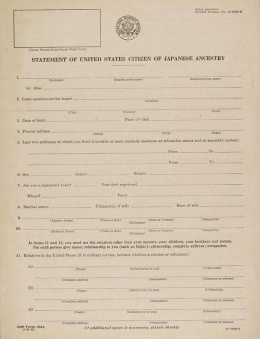Questions 27 and 28
In 1943, the War Department and the War Relocation Authority (WRA) joined forces to create a bureaucratic means of assessing the loyalty of all adults in the WRA camps, first, to prepare to extend the draft of the adult male population in camp and, second, to release "loyal" Japanese Americans from the camps for relocation to the non-restricted interior states. The final two questions on the forms created confusion and resentment.
Question number 27 asked if Nisei men were willing to serve on combat duty wherever ordered and asked everyone else if they would be willing to serve in other ways, such as serving in the Women's Army Auxiliary Corps. Question number 28 asked if individuals would swear unqualified allegiance to the United States and forswear any form of allegiance to the Emperor of Japan. Both questions caused a great deal of concern and unrest. Citizens resented being asked to renounce loyalty to the Emperor of Japan when they had never held a loyalty to the Emperor. Japanese immigrants were barred from becoming U.S. citizens on the basis of racial exclusion, so renouncing their only citizenship would be problematic. Young men worried that declaring their willingness to serve in combat units of the army would be akin to volunteering.
Issei were successful in petitioning to have question 28 revised to read: "Will you swear to abide by the laws of the United States and take no action which would in any way interfere with the war effort of the United States?" Despite the many objections Nisei had to their continued confinement without due process, their recruitment into segregated combat teams that ran in conjunction with loyalty registration, and the continued lack of clarity regarding their rights at citizens, they were unable to use the registration process as a means of restoring their citizenship rights or ending the policy of segregation for Nisei in the military.
Approximately 20,000 individuals used this questionnaire and the registration process as an opportunity to express their individual frustrations and anger with the United States government for the entire program of mass removal and incarceration by refusing to answer the questions, qualifying answers, or answering one or both of the "loyalty" questions with a "No-No" . With large numbers of Issei and Nisei not only refusing to answer the loyalty questionnaire but also requesting repatriation and expatriation to Japan, the War Relocation Authority started segregating those it had labeled the "loyal" from the "disloyal." The WRA used Tule Lake as a segregation facility.
Related Articles
For More Information
Hayashi, Brian Masaru. Democratizing the Enemy: The Japanese American Internment . Princeton, N.J.: Princeton University Press, 2004.
Lyon, Cherstin. Prisons and Patriots: Japanese American Wartime Citizenship, Civil Disobedience, and Historical Memory . Philadelphia: Temple University Press, 2011.
Muller, Eric. American Inquisition: The Hunt for Japanese American Disloyalty in World War II . Chapel Hill: University of North Carolina Press, 2007.
Omori, Emiko. Rabbit in the Moon . Hohokus, N.J.: New Day Films, 1999.
Weglyn, Michi. Years of Infamy: The Untold Story of America's Concentration Camps . Seattle: University of Washington Press, 1996.
Last updated Aug. 24, 2020, 2:47 p.m..

 Media
Media